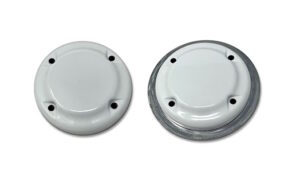 Calian GNSS Ltd. has extended its portfolio of GNSS antenna products with the addition of the triple-band and L-Band ARM972XF.
Calian GNSS Ltd. has extended its portfolio of GNSS antenna products with the addition of the triple-band and L-Band ARM972XF.
The ARM972XF employs Calian’s patented Accutenna technology providing GPS/QZSS L1/L2/L5, GLONASS-G1/G2/G3, Galileo E1/E5a/E5b, and BeiDou B1/B2a/B2b + L-Band coverage. The antenna is designed for precision triple-frequency positioning applications where light weight and a low profile are important.
The ARM972XF antenna is available in two form factors: one includes a 100mm integrated ground plane (weighs ~140 grams), and the other is 83mm in diameter and weighs ~138 grams. Both are ~19mm tall and support the ARINC mini bolt pattern of 2.0” x 1.66”. Calian’s ARM972XF is one of the smallest and lightest housed triple-band precision Mini ARINC GNSS antennas on the market. It has a very tight average phase center variation of less than 10mm for all frequencies and overall azimuths and elevation angles.
In addition to supporting two form factors, both models are available with Low Earth Orbit (LEO) qualified components.
Housed in a weatherproof IP67-rated enclosure, the ARM972XF is available in four versions. Model ARM972XF-1 (ARM972XF-1-S for LEO Space qualified components) has an integrated 100mm ground plane, model ARM972XF-2 (ARM972XF-2-S for LEO Space qualified components) is 83mm in diameter. All models are available with either a female SMA or TNC connector.
The new ARM972XF antenna includes Calian’s eXtended Filtering (XF) technology. The radio frequency spectrum has become congested worldwide as many new LTE bands have been activated, and their signals or harmonic frequencies can affect GNSS antennas and receivers. The planned Ligado service in North America, which will broadcast in the frequency range of 1526 to 1536 MHz, can affect GNSS signals. Similarly, new LTE signals in Europe [Band 32 (1452 – 1496 MHz)] and Japan [Bands 11 and 21 (1476 – 1511 MHz)] have also affected GNSS signals. Calian’s XF technology mitigates all these signals.










